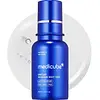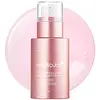What's inside
What's inside
 Key Ingredients
Key Ingredients

 Benefits
Benefits

 Concerns
Concerns

 Ingredients Side-by-side
Ingredients Side-by-side

Water
Skin ConditioningDipropylene Glycol
HumectantGlycerin
HumectantButylene Glycol
Humectant1,2-Hexanediol
Skin ConditioningNiacinamide
SmoothingSodium Polyacrylate
AbsorbentEthylhexyl Palmitate
EmollientHydrolyzed Sponge
Skin ConditioningC12-14 Alketh-12
EmulsifyingHydrogenated Polydecene
EmollientEthylhexylglycerin
Skin ConditioningAdenosine
Skin ConditioningCaprylyl/Capryl Glucoside
CleansingDisodium EDTA
Panthenol
Skin ConditioningCalcium Silicate
AbsorbentLactobacillus Extracellular Vesicles
Campsis Grandiflora Flower Extract
AntioxidantPueraria Lobata Root Extract
HumectantPinus Palustris Leaf Extract
TonicOenothera Biennis Flower Extract
AstringentUlmus Davidiana Root Extract
Skin ConditioningSodium Silicate
BufferingBetaine Salicylate
AntimicrobialCitric Acid
BufferingGluconolactone
Skin ConditioningWater, Dipropylene Glycol, Glycerin, Butylene Glycol, 1,2-Hexanediol, Niacinamide, Sodium Polyacrylate, Ethylhexyl Palmitate, Hydrolyzed Sponge, C12-14 Alketh-12, Hydrogenated Polydecene, Ethylhexylglycerin, Adenosine, Caprylyl/Capryl Glucoside, Disodium EDTA, Panthenol, Calcium Silicate, Lactobacillus Extracellular Vesicles, Campsis Grandiflora Flower Extract, Pueraria Lobata Root Extract, Pinus Palustris Leaf Extract, Oenothera Biennis Flower Extract, Ulmus Davidiana Root Extract, Sodium Silicate, Betaine Salicylate, Citric Acid, Gluconolactone
Water
Skin ConditioningButylene Glycol
HumectantDipropylene Glycol
HumectantGlycerin
HumectantNiacinamide
SmoothingSodium Polyacrylate
Absorbent1,2-Hexanediol
Skin ConditioningCaprylyl Glycol
EmollientCetearyl Olivate
Phenyl Trimethicone
Skin ConditioningSorbitan Olivate
EmulsifyingHydrolyzed Sponge
Skin ConditioningGlyceryl Acrylate/Acrylic Acid Copolymer
HumectantEthylhexylglycerin
Skin ConditioningCalcium Aluminum Borosilicate
Adenosine
Skin ConditioningDisodium EDTA
Pvm/Ma Copolymer
Emulsion StabilisingPanthenol
Skin ConditioningLactobacillus Extracellular Vesicles
Cyanocobalamin
Skin ConditioningSodium Dna
Skin ConditioningMilk Exosomes
EmollientCollagen Extract
Skin ConditioningMacadamia Ternifolia Seed Oil
EmollientCaprylic/Capric Triglyceride
MaskingAlcohol
AntimicrobialHydrogenated Lecithin
EmulsifyingPolysorbate 20
EmulsifyingRetinol
Skin ConditioningChondrus Crispus Extract
Skin ConditioningCholesterol
EmollientSodium Hyaluronate
HumectantBrassica Campestris Sterols
EmollientPolyglyceryl-10 Laurate
Skin ConditioningCeteth-3
EmulsifyingCeteth-5
EmulsifyingTocopheryl Acetate
AntioxidantHydrolyzed Elastin
EmollientPotassium Cetyl Phosphate
EmulsifyingHydroxypropyltrimonium Hyaluronate
Acetyl Tetrapeptide-5
HumectantPalmitoyl Pentapeptide-4
Skin ConditioningSodium Acetylated Hyaluronate
HumectantHydrolyzed Hyaluronic Acid
HumectantPalmitoyl Tripeptide-5
Skin ConditioningHyaluronic Acid
HumectantSodium Hyaluronate Crosspolymer
HumectantHydrolyzed Sodium Hyaluronate
Skin ConditioningPotassium Hyaluronate
Skin ConditioningWater, Butylene Glycol, Dipropylene Glycol, Glycerin, Niacinamide, Sodium Polyacrylate, 1,2-Hexanediol, Caprylyl Glycol, Cetearyl Olivate, Phenyl Trimethicone, Sorbitan Olivate, Hydrolyzed Sponge, Glyceryl Acrylate/Acrylic Acid Copolymer, Ethylhexylglycerin, Calcium Aluminum Borosilicate, Adenosine, Disodium EDTA, Pvm/Ma Copolymer, Panthenol, Lactobacillus Extracellular Vesicles, Cyanocobalamin, Sodium Dna, Milk Exosomes, Collagen Extract, Macadamia Ternifolia Seed Oil, Caprylic/Capric Triglyceride, Alcohol, Hydrogenated Lecithin, Polysorbate 20, Retinol, Chondrus Crispus Extract, Cholesterol, Sodium Hyaluronate, Brassica Campestris Sterols, Polyglyceryl-10 Laurate, Ceteth-3, Ceteth-5, Tocopheryl Acetate, Hydrolyzed Elastin, Potassium Cetyl Phosphate, Hydroxypropyltrimonium Hyaluronate, Acetyl Tetrapeptide-5, Palmitoyl Pentapeptide-4, Sodium Acetylated Hyaluronate, Hydrolyzed Hyaluronic Acid, Palmitoyl Tripeptide-5, Hyaluronic Acid, Sodium Hyaluronate Crosspolymer, Hydrolyzed Sodium Hyaluronate, Potassium Hyaluronate
 Reviews
Reviews

Ingredients Explained
These ingredients are found in both products.
Ingredients higher up in an ingredient list are typically present in a larger amount.
1,2-Hexanediol is a synthetic liquid and another multi-functional powerhouse.
It is a:
- Humectant, drawing moisture into the skin
- Emollient, helping to soften skin
- Solvent, dispersing and stabilizing formulas
- Preservative booster, enhancing the antimicrobial activity of other preservatives
Adenosine is in every living organism. It is one of four components in nucleic acids that helps store our DNA.
Adenosine has many benefits when used. These benefits include hydrating the skin, smoothing skin, and reducing wrinkles. Once applied, adenosine increases collagen production. It also helps with improving firmness and tissue repair.
Studies have found adenosine may also help with wound healing.
In skincare products, Adenosine is usually derived from yeast.
Learn more about AdenosineButylene Glycol (or BG) is used within cosmetic products for a few different reasons:
Overall, Butylene Glycol is a safe and well-rounded ingredient that works well with other ingredients.
Though this ingredient works well with most skin types, some people with sensitive skin may experience a reaction such as allergic rashes, closed comedones, or itchiness.
Learn more about Butylene GlycolDipropylene Glycol is a synthetically created humectant, stabilizer, and solvent.
This ingredient helps:
Dipropylene glycol is technically an alcohol, but it belongs to the glycol family (often considered part of the ‘good’ alcohols). This means it is hydrating and gentle on skin unlike drying solvent alcohols like denatured alcohol.
As a masking agent, Dipropylene Glycol can be used to cover the smell of other ingredients. However, it does not have a scent.
Studies show Dipropylene Glycol is considered safe to use in skincare.
Learn more about Dipropylene GlycolDisodium EDTA plays a role in making products more stable by aiding other preservatives.
It is a chelating agent, meaning it neutralizes metal ions that may be found in a product.
Disodium EDTA is a salt of edetic acid and is found to be safe in cosmetic ingredients.
Learn more about Disodium EDTAEthylhexylglycerin (we can't pronounce this either) is commonly used as a preservative and skin softener. It is derived from glyceryl.
You might see Ethylhexylglycerin often paired with other preservatives such as phenoxyethanol. Ethylhexylglycerin has been found to increase the effectiveness of these other preservatives.
Glycerin is already naturally found in your skin. It helps moisturize and protect your skin.
A study from 2016 found glycerin to be more effective as a humectant than AHAs and hyaluronic acid.
As a humectant, it helps the skin stay hydrated by pulling moisture to your skin. The low molecular weight of glycerin allows it to pull moisture into the deeper layers of your skin.
Hydrated skin improves your skin barrier; Your skin barrier helps protect against irritants and bacteria.
Glycerin has also been found to have antimicrobial and antiviral properties. Due to these properties, glycerin is often used in wound and burn treatments.
In cosmetics, glycerin is usually derived from plants such as soybean or palm. However, it can also be sourced from animals, such as tallow or animal fat.
This ingredient is organic, colorless, odorless, and non-toxic.
Glycerin is the name for this ingredient in American English. British English uses Glycerol/Glycerine.
Learn more about GlycerinHydrolyzed sponge comes from marine or freshwater sponges. This is the main ingredient for "spicules".
In some products, tiny microneedles called spicules are made from silica or hydrolyzed sponge. They help push active ingredients into the skin to enhance the penetration and efficacy of these ingredients.
Niacinamide is a multitasking form of vitamin B3 that strengthens the skin barrier, reduces pores and dark spots, regulates oil, and improves signs of aging.
And the best part? It's gentle and well-tolerated by most skin types, including sensitive and reactive skin.
You might have heard of "niacin flush", or the reddening of skin that causes itchiness. Niacinamide has not been found to cause this.
In very rare cases, some individuals may not be able to tolerate niacinamide at all or experience an allergic reaction to it.
If you are experiencing flaking, irritation, and dryness with this ingredient, be sure to double check all your products as this ingredient can be found in all categories of skincare.
When incorporating niacinamide into your routine, look out for concentration amounts. Typically, 5% niacinamide provides benefits such as fading dark spots. However, if you have sensitive skin, it is better to begin with a smaller concentration.
When you apply niacinamide to your skin, your body converts it into nicotinamide adenine dinucleotide (NAD). NAD is an essential coenzyme that is already found in your cells as "fuel" and powers countless biological processes.
In your skin, NAD helps repair cell damage, produce new healthy cells, support collagen production, strengthen the skin barrier, and fight environmental stressors (like UV and pollution).
Our natural NAD levels start to decline with age, leading to slower skin repair, visible aging, and a weaker skin barrier. By providing your skin niacinamide, you're recharging your skin's NAD levels. This leads to stronger, healthier, and younger looking skin.
Another name for vitamin B3 is nicotinamide. This vitamin is water-soluble and our bodies don't store it. We obtain Vitamin B3 from either food or skincare. Meat, fish, wheat, yeast, and leafy greens contain vitamin B3.
The type of niacinamide used in skincare is synthetically created.
Learn more about NiacinamidePanthenol is a common ingredient that helps hydrate and soothe the skin. It is found naturally in our skin and hair.
There are two forms of panthenol: D and L.
D-panthenol is also known as dexpanthenol. Most cosmetics use dexpanthenol or a mixture of D and L-panthenol.
Panthenol is famous due to its ability to go deeper into the skin's layers. Using this ingredient has numerous pros (and no cons):
Like hyaluronic acid, panthenol is a humectant. Humectants are able to bind and hold large amounts of water to keep skin hydrated.
This ingredient works well for wound healing. It works by increasing tissue in the wound and helps close open wounds.
Once oxidized, panthenol converts to pantothenic acid. Panthothenic acid is found in all living cells.
This ingredient is also referred to as pro-vitamin B5.
Learn more about PanthenolSodium Polyacrylate is the sodium salt of polyacrylic acid. It is used as an absorber, emollient, and stabilizer.
This ingredient is a super-absorbent polymer - meaning it can absorb 100 to 1000 times its mass in water. As an emollient, Sodium Polyacrylate helps soften and soothe skin. Emollients work by creating a barrier to trap moisture in. This helps keep your skin hydrated.
Water. It's the most common cosmetic ingredient of all. You'll usually see it at the top of ingredient lists, meaning that it makes up the largest part of the product.
So why is it so popular? Water most often acts as a solvent - this means that it helps dissolve other ingredients into the formulation.
You'll also recognize water as that liquid we all need to stay alive. If you see this, drink a glass of water. Stay hydrated!
Learn more about WaterLactobacillus Extracellular Vesicles are tiny particles released by Lactobacillus bacteria into their growth liquid. These are then collected from the culture medium.